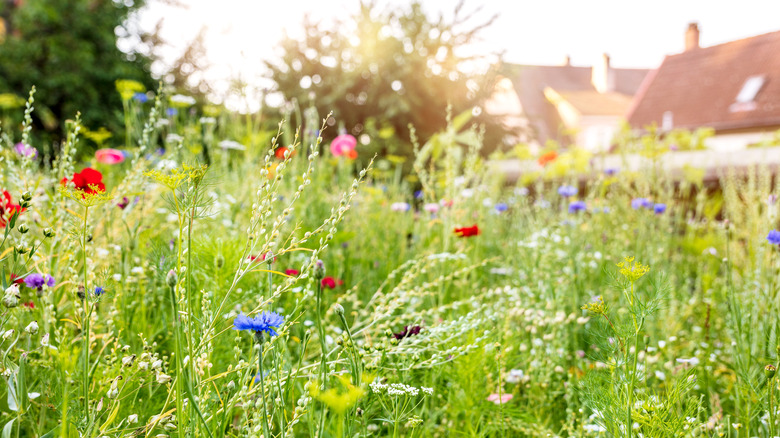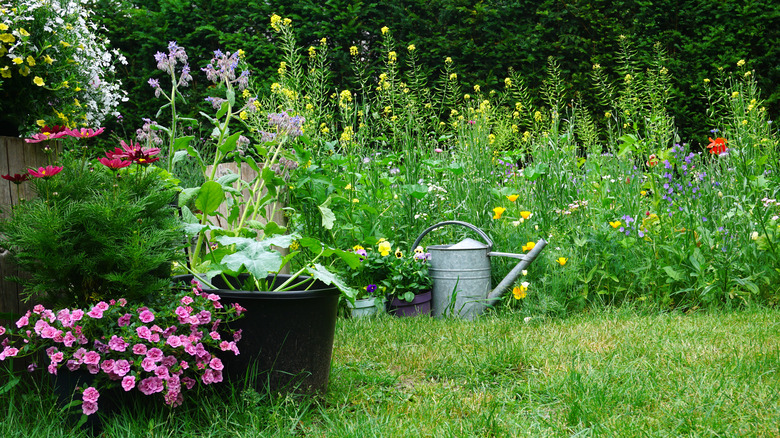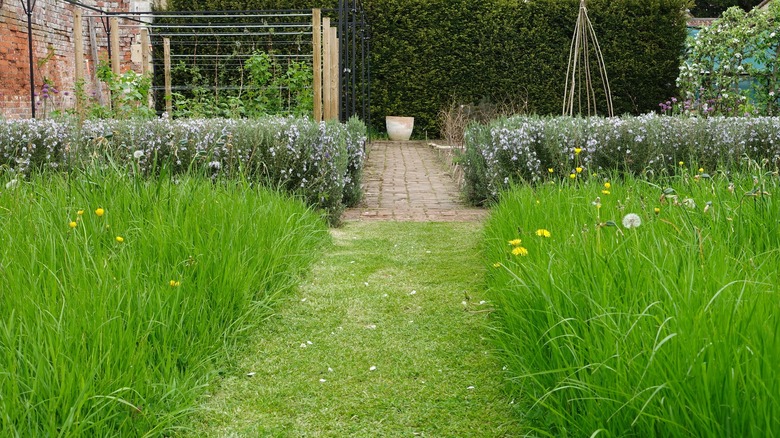What Is Meadowscaping And How To Get The Look In Your Garden
Lots of gardeners know how beneficial working outdoors can be for physical and mental well-being, but this healthy hobby can get expensive quickly for both people and the planet. If you regularly water your lawn or garden, you're pouring between 30 and 60% of your household's total water usage straight into the grass, with little to no benefits in return (via the Environmental Protection Agency). Lawns might seem pretty, but these vast swathes of grass are sometimes referred to as "green deserts" because their lack of biodiversity doesn't purify the air, prevent soil erosion, or help pollinators. In fact, all that wasted space forces bees and butterflies to travel long distances in hopes of finding food, and the popularity of insecticides makes lawns a deadly rest stop.
Are you tired of battling with fickle flowers and stubborn weeds? Worried about the environmental consequences of maintaining a curated lawn or garden? Even if you're just interested in cutting your water bill in half, it may be time to try out a more eco-friendly alternative to typical lawns: Meadowscaping. Learn more about this up-and-coming natural gardening trend and how you can use it to transform your outdoor space.
What is meadowscaping?
Meadowscaping is a form of landscaping design that embraces natural growth. Meadowscaping reflects English countryside gardens and cottagecore aesthetics, with colorful wildflowers, tall grasses, and freeform garden beds serving as key aspects of the trend. Another step forward in the anti-lawn movement, meadowscaping aims to create low-maintenance gardens that are better for people, the planet, and pollinators like bees, birds, bats, and butterflies.
Zolene Quindoy, head horticulturist at Yardzen, explained to Martha Stewart, "The style favors soft and wild ornamental grasses like silvergrass, lomandra, and blue fescue, which give you an organic look that requires little upkeep." Quindoy also frames meadowscaping as part of a broader trend in organic, untamed landscapes, commenting, "We'll continue to see homeowners who want to reduce water-intensive lawns and replace them with alternative species like clover, install low-water edible front yards, or re-wild their yards with native and climate-adapted species that require far less maintenance, water, and fertilizer." Aside from being healthy for your wallet and the planet, meadowscapes have a natural, wild beauty that can't be matched by stuffy, curated lawns. Picture soft switch grass, bright bee balm and black-eyed Susan, fireweed, and even local varieties like Texas bluebonnets and Mexican feathergrass. Meadowscaping can also be a great way to appreciate more of your natural surroundings and learn about useful native plants and herbs.
Creating your own meadowscapes
You don't need to have acres and acres of land to pull off a meadowscaped look. Meadowscaping can be a great way to fill in awkward patches where nothing seems to grow or create a low-maintenance alternative to shallow, lifeless lawn space. Most meadow plants thrive under full sun, and many also benefit from being drought-tolerant and deer-resistant. However, soil conditions are very important for grasses and wildflowers, so be sure to till dense soil before planting and add compost or peat moss if needed. Plan where you'd like to lay gravel paths, mow through, or place stepping stones for easier access and watering.
As you're designing your perfectly untamed garden, Quindoy advises, "Think unfussy wildflowers, romantic arbors, meandering gravel paths, and mixing and matching plants and styles in a way that feels natural and whimsical" (via Martha Stewart). Research native wildflowers and grasses and purchase several seed varieties. These seeds should be sown in mid to late fall for the best results in spring. Toss the seeds in loose clumps or thoroughly mix them by hand for a more natural effect. After your grasses and wildflowers are established, add dimension with your favorite pollinator-friendly blooms like coneflowers, lilac, honeysuckle, asters, garden phlox, lavender, daisies, or sunflowers. Finally, let nature take its course! Water and trim back your meadowscape as needed, but allow the flowers to grow freely and enjoy watching the pollinators thrive.


